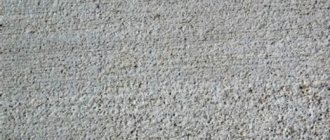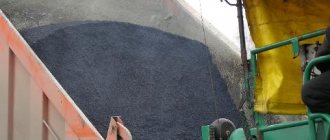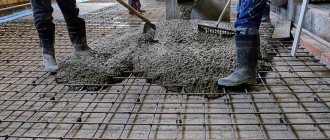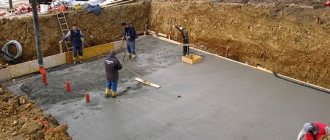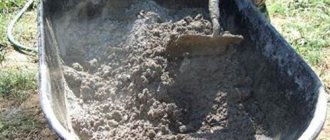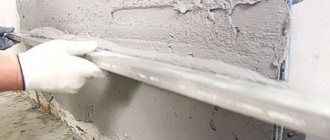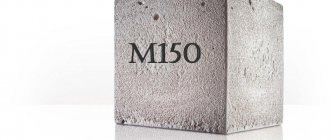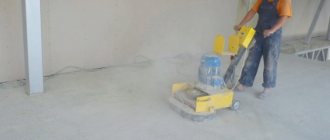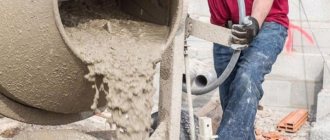Components
Companies produce this type of material according to individual production recipes, hiding the details of the composition. However, the basic consistency includes standard components. The set of properties inherent in varieties of quick-hardening powder is provided by the following additives:
- quicklime;
- potash;
- hydrochloric acid;
- various salts.
Based on their percentage, the rate of hardening and development of higher strength may vary, but the process still proceeds as quickly as possible. Also, production does not exclude the use of various mineral additives and other components (of non-mineral origin) to increase plasticity, ensure waterproofing ability, chemical resistance and other quality indicators.
Two main stages of hardening
To achieve the declared qualities, it is necessary to maintain the correct proportions when mixing the solution. Only in this case will the desired strength be achieved. About an hour after pouring the mixture, the process of changing its structure begins. This stage is called setting. How long does it take for the cement mortar to harden before further work is continued?
After a day, the mass becomes so strong that you can walk on it. But it is still far from the declared brand strength. This was only the first stage, called grasping. Next, the hardening process begins. After two days, the mixture gains about 50% strength in the warm season.
It is recommended to begin full operational load and operations for the further construction of the next floor no earlier than 28 days, when the concrete strength approaches 90% as stated. Particular importance is attached to time during the construction of load-bearing structures. If possible, it is better to pour strong foundations a year before the start of main construction. During this time, almost all processes of structure change occur. There will be no significant changes to the geometry of the structure. It is difficult to determine the exact time for complete hardening of a particular cement mortar. It can last for years, but after 12 months these changes do not affect the quality of the building.
Currently reading: Composition of architectural concrete, manufacturing technology, area of application of archstone
Areas of operation
Often, quick-drying powder is used when it is necessary to restore any structure. In buildings and structures, such building material is necessary for waterproofing, puttying, sealing various defective areas of the surface, repairs on foundations and plinths.
Modern (new) approaches to architecture suggest that such concrete can be poured under anchors, metal structures and other parts, and also used in stove masonry, stucco molding and installation of columns.
Application area
Typically, quick-setting cement is used in the production of reinforced concrete products where the structure cannot be steamed in a chamber. For example, this could be the production of foundation blocks.
The properties of the mortar are also important in the process of masonry work during rapid construction - in this case, it is possible to avoid downtime and significantly save on the time of using special equipment, paying workers, and reducing project implementation time.
It is also important to use a quick-hardening solution in the production of paving stones, less often concrete curbs, floor slabs and other structures. The main purpose of quick-setting cement is to speed up the process of completing work without losing the characteristics of strength and resistance to various influences.
Key Features
As already mentioned, the key advantage of such powders is their instant hardening. If in basic varieties it takes at least an hour for initial setting, then in quickly hardening varieties it takes from 1 to 5 minutes. Moreover, under such conditions, concrete mixtures self-compact, filling cracks and holes. Accordingly, the integrity of any ceiling can be restored in the shortest possible time. These are also powders used at high humidity and low temperatures.
Installation of beacons
Beacons for screeds
Lighthouses
For an even screed, beacons are installed - special metal profiles or wood blocks. The guides are located at the same level, where the height of the screed ends above the base. The work is performed with a level or level.
During installation, the horizontalness and height of the beacons are checked
Checking the horizontality of beacons
The beacon can be located in the screed or removed from it after the structure is completed. If the guide remains in the screed, it is treated with anti-corrosion and water-repellent compounds. But it is better to remove wood products from the structure, as they are susceptible to destruction.
Stages of work.
- About 25 cm is removed from the wall and the first beacon is installed. The remaining products are located at a distance of approximately 40 cm from it.
- In the place where the profile will be placed, tubercles are made of cement with a small distance between them. The beacon rests on the tubercles.
- The guides are placed around the perimeter of the room and left until the cement solution dries. Afterwards the screed is performed.
Nuances of operation
In fact, preparing the working consistency is no different from the standard one. Clinker grinding is still mixed with water, sand and solid fillers (if necessary). But in this case, it is necessary to remember about the active components that cause setting within 1-5 minutes. Accordingly, the prepared mass should be consumed within the specified time. By distributing it over the treated area in a timely manner, a high-quality coating is obtained.
It is impossible to dilute the setting building material: it will lose its qualities. Carefully monitor the content of components in the prepared concrete mass, using the instructions from the manufacturer. Be sure to prepare the surface to be treated by cleaning it. Add the liquid to the mixture evenly and slowly, using a construction mixer at low speed to prepare the optimal consistency.
In many situations, using conventional cement is ineffective and inconvenient because you have to wait a long time for hardening, and this is not always possible, for example, working outside in slushy or rainy weather. That is why special quick-drying cements are used. Rapid hardening is given to it by special mineral additives that can crystallize very quickly upon contact with water, creating a monolith. Such solutions are capable (depending on the thickness of the installation) of hardening in 3 days, a maximum of 28, but this is a very powerful layer of cement under very difficult weather conditions. After all, it can be used when the street is below -27 degrees Celsius!!! Quick-drying cement is used in the manufacture of reinforced concrete products, frost-resistant concrete, as well as during emergency restoration work.
It is important to know that such cement cannot be stored for a long time without using it, since after 1-2 months the property of rapid hardening disappears. Also, you should not use it in an aggressive, chemical environment, because mineral additives are not resistant to acids and alkalis. Concrete structures based on such cements cannot be used for massive structures due to temperature differences inside and outside the product.
Recently, additives that promote rapid hardening have been improved, due to which their amount in the solution has become only from 2 to 5%, and in addition they increase the strength of the products by a whole step. Thanks to this, costs for electricity and fuel have been reduced, since now factories do not need to additionally steam the manufactured structures.
Quick-drying cements are available in white and colored varieties. And the gray color of standard cement is explained by the content of manganese and iron oxides in its composition. To obtain white color, raw materials such as kaolin clay or chalk, which contain very few manganese and iron compounds, are used. White cements come in two grades - “400” and “500”. The colored stamps are the same, but “300” is added. Multi-colored cements are obtained by adding dyes to their composition; their range is absolutely diverse. But for such a nice appearance you have to pay for not having such good resistance to low temperatures as white ones, low resistance to corrosion, and are also more susceptible to shrinkage.
There are also cement powders that absorb or, conversely, repel water. This is easy to check, just drop water on a handful of powder. If water is absorbed in the first seconds, then the cement is absorbent, or hydrophilic, and if it is not absorbed within 4-5 minutes, then the powder repels water, that is, hydrophobic. Concrete made from such “anti-water” cement will last longer, which is why it is used in more critical structures. In addition, it is not afraid of long-term storage.
There is also monolithic cement, which, even for its use at military facilities, received this name - “military” cement, its brand is “600”.
Recently, suppliers have not been satisfied with the quality of cement mixtures, their properties have decreased, which in turn has led to low-quality structures that are not able to withstand the cold and exposure to moisture that they could easily withstand before. This suggests that domestic manufacturing plants do not comply with GOSTs established for cement production, while representatives from Europe, on the contrary, remained at the same level in this regard, and in some ways even improved the quality! At the same time, its price is not much higher than the price of Russian cement. Examples of the use of European cement include subway tunnels, all kinds of water supply and sewer drains, and all those objects that are constantly exposed to high humidity and temperature fluctuations.
Moving a little away from the topic (but it wouldn’t hurt to know this either), I would also like to mention acid-resistant cements, which, like fast-hardening ones, have a very high hardness and are also very resistant to the aggression of acidic environments. The difference between these types of cement is the following: this type hardens much longer and when exposed to water, the process of destruction begins.
How to work with quick-drying solutions? Very simple!!! A solution of cement, granulated sand and water is mixed. The resulting composition must be consumed within an hour, so the solution should be mixed in portions. It is applied only to the prepared surface (that is, not frozen, clean and dry, there should be no greasy stains, paints or old plaster), in layers, each of which is leveled. The temperature at which such work should be carried out is recommended by experts and is +10…+25 degrees. Also, it is necessary to prevent exposure to drafts and sunlight until curing after 3 days.
offers cement brand PC 500D20 from a warehouse in Pskov.
Purchase of quality building materials
By turning to the services of the group, you are guaranteed to be able to buy high-quality construction powders to perform the procedures described above. We serve the entire Central Federal District of the Russian Federation, as well as the city of Moscow, promptly delivering orders, respecting the rights of customers and fulfilling our own responsibilities. You can receive products from leading domestic and foreign factories on favorable terms.
Carefully study the sections of our website and read thematic articles to learn more about all the nuances of using this category of building materials. Leave your requests or call us directly to discuss order details. Competent managers promptly respond to every request. Waiting for you!
Fast drying cement
Cement. Basic concepts Everyone knows that cement is practically the most important material in the construction of any kind of buildings, structures, communications and the like. It is worth noting that cement is part of the group of binders that gradually harden when interacting with water.
Production. A few numbers. 3.590 billion tons - this is exactly the figure that global cement production reached by the end of 2013. The three largest cement producing countries have also become known: China with 1.8 billion tons, India with 220 million tons and the United States with cement production of 63.5 million tons. Also, Rosstat reported that the production of Portland cement, aluminous cement and other cement materials in 2012 amounted to 61.5 million tons.
On European exchanges the price of one ton of cement is about 100 US dollars, in China – 40 US dollars. The majority of exchange transactions in cement are carried out on the Moscow Stock Exchange in Moscow.
Cement is a building material, the use of which helps to create products, structures and buildings with high strength. And at the same time, cement can be used as a completely independent material, and not just as a component. This material is created by grinding and sintering one type of clay or clay and limestone. It is in the process of mixing various substances and additives that cement acquires certain properties. Also, precisely because of the mixing of different types of cement, the addition of various substances, cement is divided into two groups: slag Portland cement and Portland cement. In turn, these two types of cement are divided into other subtypes.
Today we will look at one type of Portland cement. Today, depending on the conditions and features of construction, completely different types of cement can be used. It was to indicate the maximum strength of cement that various brands began to be used. The most common grades today are from 350 to 500, but this does not mean that there is no cement with grade M 600. All cements harden quite quickly: from a minimum of 30 minutes to 12 hours.
Of course, cement, like all other building materials, there are several types that are used depending on the construction conditions. Also, almost every type of cement has two of its own individual markings: what load this cement can withstand and the ratio (in percentage) of other additives to the total volume of cement.
Cement production methods can be divided into two main types.
"Wet" method. With this production method, chalk, clay and iron-containing additives are used as raw materials. In this case, certain conditions must also be met: the moisture in clay should be no more than 20%, and in limestone – no more than 29%. This method got its name due to the fact that the mixing and grinding process takes place in an aqueous environment. As a result of grinding, a semi-liquid mixture is obtained, which is sent to a special oven. In this kiln, during firing, carbon dioxide is removed and clinker balls remain, which are ground into powder and cement is obtained.
Technical characteristics and properties of M900 cement
Today, grade 900 cement is not a very common building material, few people even know anything about it, but it exists, and its properties and physical and technical characteristics differ:
- Grinding fineness (Blaine scale) – 900 kg/sq.m. m.
- Density - in cement 900 the indicator is 900 kg / cubic meter. m.
- Setting time. With a ratio of water and cement of 1:1 (by weight) and at a temperature of +20°C, the setting process begins after 60-120 minutes (according to the Vicat instrument - penetration 1 mm) and ends after 120-150 minutes.
- High performance.
- Stability.
- Ecologically clean and safe for the environment (there are no hazardous components in the composition).
- Economical.
- Can be used in conjunction with standard injection equipment.
Important! Portland cement 900 is ground from pure clinker and only thanks to the smallest particle sizes it is able to penetrate (penetrate) into tight joints, pores at the molecular level, tiny cracks and spaces between mineral granules, thus providing reliable waterproofing for rocks or soil masses.
You can familiarize yourself on the website with such brands of cement as: M300 and M500, M400 and M600, as well as the M700 cement brand.
